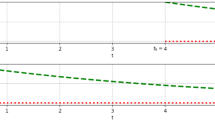We study the optimal economic growth model based on the controlled Kaldor businesscycle model and formulated as an infinite-horizon optimal control problem. We show that the original problem is approximated by standard problems on finite intervals and obtain conditions guaranteeing that the Pontryagin maximum principle for the problem under consideration holds in the normal form with explicitly given adjoint variable.
Similar content being viewed by others
References
A. S. Aseev, “Optimal stationary regimes in Kaldor’s business cycle controlled model,” Math Models Comput. Simul. 11, 750-758 (2019). https://doi.org/https://doi.org/10.1134/S2070048219050028
H.-W. Lorenz, Nonlinear Dynamical Economics and Chaotic Motion, Springer, Berlin etc. (1993).
A. F. Filippov, Differential equations with Discontinuous Right-Hand Sides, Kluwer, Dordrecht (1988).
D. Acemoglu, Introduction to Modern Economic Growth, Princeton Univ. Press, Princeton (2008).
R. J. Barro and X. Sala-i-Martin, Economic Growth, McGraw Hill, New York (1995).
M. J. Weitzman, Income, Wealth, and the Maximum Principle, Harvard Univ. Press, Cambridge, MA (2003).
D. A. Carlson, A. B. Haurie, and A. Leizarowitz, Infinite Horizon Optimal Control: Deterministic and Stochastic Systems, Springer, Berlin (2011).
A. F. Filippov, “On some questions of optimal control” [in Russian], Vestn. Mosk. Univ., Ser. Matr. Mekh. Astron. Fiz. Khim. 14, No. 2, 25–32 (1959).
L. Cesari, Optimization — Theory and Applications. Problems with Ordinary Differential Equations., Springer, New York etc. (1983).
S. M. Aseev and A. V. Kryazhimskii, “The Pontryagin maximum principle and optimal economic growth problems,” Proc. Steklov Inst. Math. 257, 1–255 (2007).
L. S. Pontryagin, V. S. Boltyanskij, R. V. Gamkrelidze, and E. F. Mishchenko, The Mathematical Theory of Optimal Processes, Pergamon Press, Oxford etc. (1964).
F. H. Clarke, Optimization and Nonsmooth Analysis, John Wiley and Sons, New York (1983).
Author information
Authors and Affiliations
Corresponding author
Additional information
Translated from Problemy Matematicheskogo Analiza 125, 2023, pp. 37-45.
Rights and permissions
Springer Nature or its licensor (e.g. a society or other partner) holds exclusive rights to this article under a publishing agreement with the author(s) or other rightsholder(s); author self-archiving of the accepted manuscript version of this article is solely governed by the terms of such publishing agreement and applicable law.
About this article
Cite this article
Aseev, A.S. Optimal Economic Growth Problem. J Math Sci 276, 37–47 (2023). https://doi.org/10.1007/s10958-023-06723-4
Received:
Published:
Issue Date:
DOI: https://doi.org/10.1007/s10958-023-06723-4



